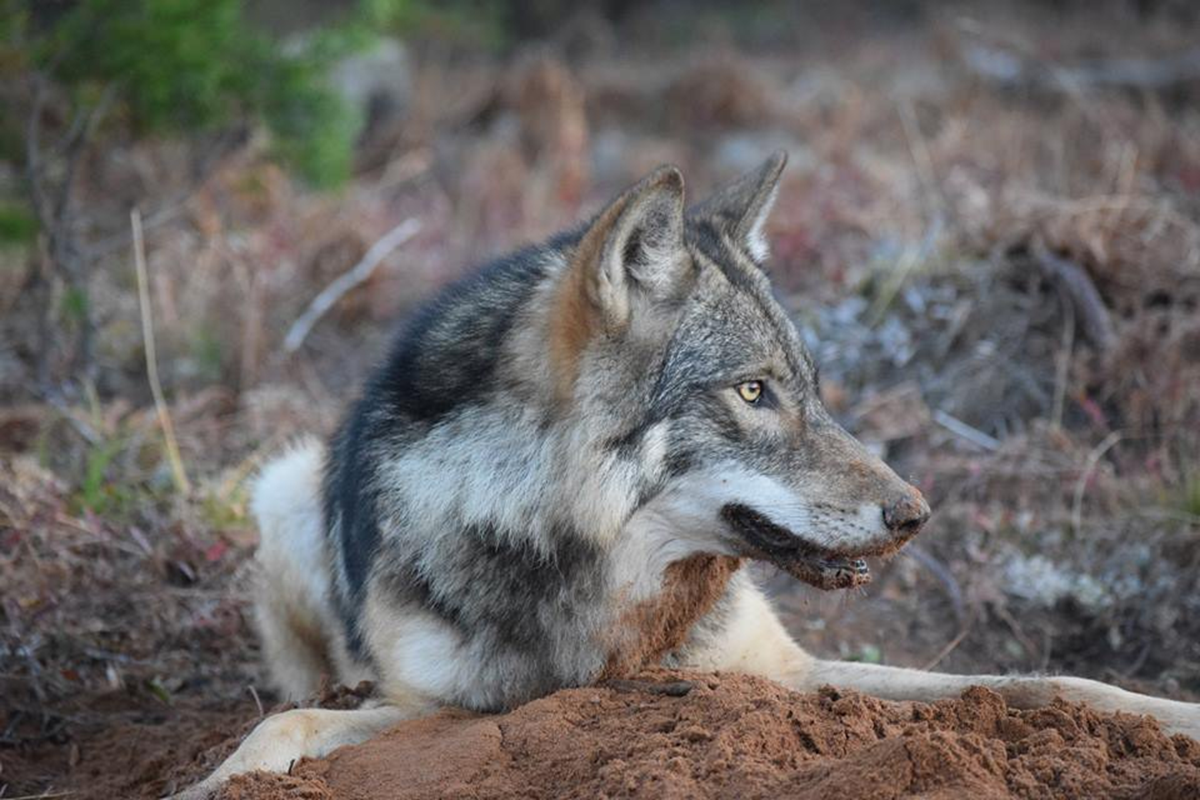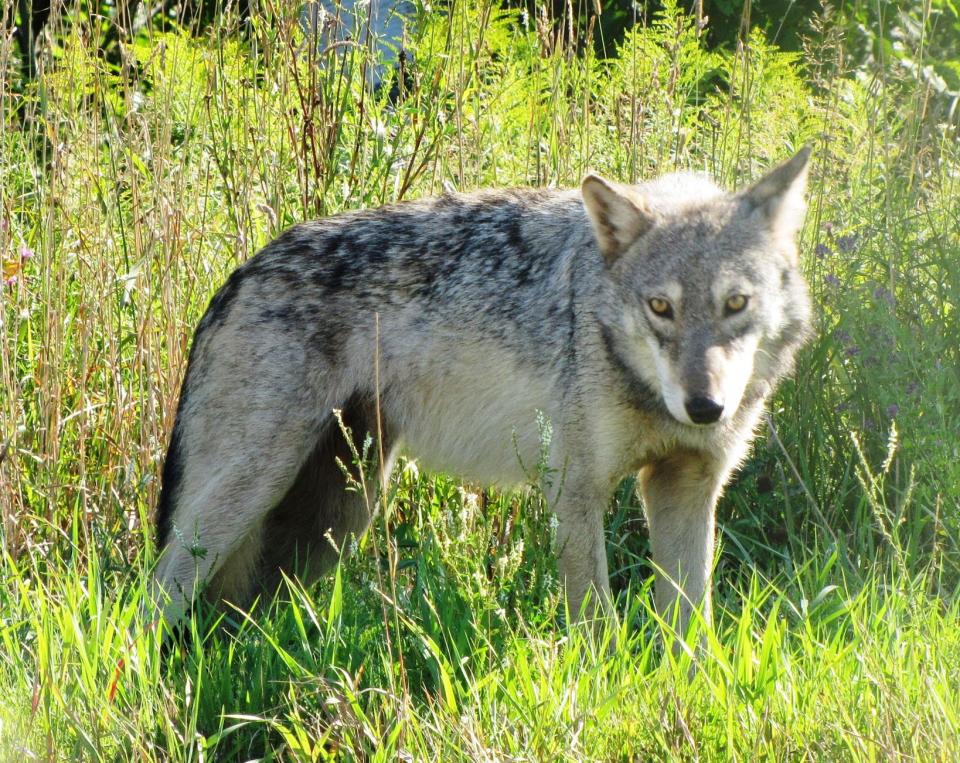Gray wolves, the U.P.’s most controversial animal

UPPER PENINSULA — The memory of the first time Denise Amo spotted a wolf in the Upper Peninsula has remained crystal clear over the years.
“I wish I could’ve filmed it, but we didn’t all have smartphones in our pockets back then,” said Amo, a retired 32-year Brimley resident who lives on the shores of Lake Superior.
“It was in the depths of winter shortly after we moved here,” she recalled. “The ice on Whitefish Bay was at its thickest, and it was an unusually clear, calm day. I happened to look out over the bay towards Ontario and there it was, a wolf crossing the ice, probably migrating from Ontario to Michigan, or perhaps returning to a pack. The wolf trotted confidently across the frozen bay like a large dog, but far more elegant, alert, graceful and wild. I knew right away I was in the proximate company of a truly regal creature, and while the days before and after that moment are lost to me like the infinite grains of sand Lake Superior gives and takes each season, that particular moment is one I will never forget.”
It’s been over three decades since gray wolves returned to the Upper Peninsula, but a sighting like Amo’s is still incredibly rare. Yet even if locals and visitors don't see them, knowing wolves are out there in the wild U.P. landscape provides cultural benefits.
“People value them,” said Kristie Sitar, a 22-year veteran wildlife biologist with the Michigan DNR based in Newberry. “Even if they never see them, they know they’re out there, and that has value.”

As a top predator, wolves also benefit the ecosystems in which they live. According to the DNR, wolves have a positive natural selection effect on the ecosystem, with the return of wolves to the U.P. having similar yet less obvious ecological effects as the nationally renowned return of wolves to Yellowstone National Park.
“They prey on whitetail deer, beaver and hare, just to name a few,” said Sitar. “While most of their hunts are unsuccessful, their successful hunts usually involve taking down the elderly, sick, infirm, weak and malnourished. Their hunting patterns are a story in natural selection, which then improves the overall health of every prey population they hunt.”
Yet, some residents are not thrilled with the presence of wolves in the U.P.
“Livestock and pet conflicts, mostly wolf-dog encounters, are legitimate concerns we hear from some residents,” said Brian Roell, a Marquette-based DNR wildlife biologist who specializes in wolves and other large carnivores. “Incidents are extremely rare, especially considering how vast the U.P landscape is and how many pets there are, but such incidents do happen due to the wolf’s naturally territorial behavior.”
Officials noted there is much the public can do to prevent wolf-dog conflicts. The vast majority of wolf-dog encounters involve hunting hounds, so the DNR provides four recommendations for preventing such encounters:
Report all suspected wolf-dog conflicts to the DNR immediately.
Become familiar with coyote and dog tracks to distinguish them from wolf tracks.
Consider adding bells or beepers to dog collars. Some hunters have reported this can reduce wolf attacks.
Remain up-to-date on wolf-dog conflicts in the area by periodically checking the map of wolf-dog conflict events.
The DNR created an online map that updates geographic locations where wolf-dog interactions have occurred. Since recording began in 2009, 80 dogs have been killed by wolves in the U.P. The majority of those incidents, 51, occurred between 2009 and 2014. Also, 67 of the 80 were hunting dogs.
Though rare, livestock and pet conflicts are also legitimate concerns, yet they're only the beginning of wolf-related controversy. Some U.P. residents, including members of the Straits Area Sportsmen's Club, said they believe the return of wolves is to blame for the declining deer population.
Subscribe: Check out our offers and read the local news that matters to you
Deer in the U.P. are well-studied, and while the return of a predator to the ecosystem will have an effect, officials said it is not the primary cause of declining deer numbers.
“Severe winter weather is the most significant factor limiting deer abundance,” said Sitar. “Since 1996, the Upper Peninsula experienced more than three times as many severe winters as compared to the 1980 to 1996 recording period, along with two instances of back-to-back and two instances of three consecutive severe winters. Severe winters place significant stress on adult deer, leading to low birth weight in fawns and higher fawn mortality, which, even under normal conditions, is already quite high (47 percent).
"Also, severe winters and the predation that does occur go hand-in-hand," she said. "Climate change’s effects on the Great Lakes have led to less ice coverage and more lake effect snow. More snowpack means more deer predation by bears, coyotes, bobcats and wolves, as deer are less able to flee predators in heavy snow.”
DNR wildlife biologists led by Sitar and Roell published a paper that compiled months of research into the physical condition of deer at different stages of the year, particularly during heavy snowfall and especially when preyed upon by wolves in heavy snow. During the study period, Sitar and Roell found that nearly 70 percent of wolf predations of adult deer occurred in the late winter and spring months when the body condition of deer was at its poorest. Further investigation into adult deer killed by wolves in the high snowfall zones found that nearly half (43 percent) were in extremely poor nutritional condition and likely would not have survived the winter even if they were not preyed upon.
Another concern among some residents is the size of the wolf population. Some sportsmen with deer camps set up throughout the U.P. use trail cameras to track deer movement, and they claim the sheer number of wolf images they collect must mean there are more wolves in the Upper Peninsula than the DNR’s latest 2022 minimum population survey of 631 wolves plus or minus 49.
More: Michigan DNR releases 2022 wolf population survey
More: Gray wolf ends up in southwest Michigan, far from U.P. habitat, sparking DNR mystery
The assumption that thousands of images of wolves captured on trail cameras means thousands of wolves living in the U.P. is not true, said DNR wildlife biologists. They counter that argument in three parts:
First, wolves cover a lot of ground daily, often branching off in different directions.
“Five wolves you see on a trail cam photo do not move like the five fingers on your hand,” said Roell. “They branch off and go out on their own for days before returning to the pack. Wolves are nature’s best long-distance joggers. A wolf runs across terrain for 10-12 hours every day of its life, and each pack’s territory is huge.”
Second, how wolves move across a landscape compared with where trail cameras are placed makes it extremely likely one will capture images of wolves.
“They stick to trails, roads and two-tracks because they’re easier to move through, but those are also the same places hunters place trail cams, leading to a higher incidence of wolf images than if cams were placed in the middle of thick forest and heavy undergrowth,” said Roell. “A couple landowners living in the same area who capture 40 images of wolves throughout their properties are likely spotting the same pack of 4-5 wolves, not 40 individual wolves.”
Finally, the U.P. cannot biologically sustain a population of thousands of wolves. The DNR shows this using math and data about gray wolves.
“You can estimate the wolf population if you know a few data points,” said Sitar. “Two studies from 2005 and 2017 arrived at the same conclusion as to what percentage of the U.P.’s 16,378 square miles of land is suitable wolf habitat. The studies found 63 percent of the U.P., or 10,395 square miles, is suitable habitat for wolves and is also currently occupied by wolves, meaning the available habitat has reached its saturation point, also known as biological capacity.
"Take 10,395 and divide it by 82, the average square mile territory size of a wolf pack. Multiply that by 4.8, which is the average gray wolf pack size in this part of the country.”
The result? From Sitar’s math, 608 wolves in the U.P., right within the population range the DNR estimated in their 2022 survey.
Sitar and Roell both said wolves remain controversial because humans have competed with them for resources for thousands of years. From the perspective of the scientists who study them, today’s challenge lies in humankind's ability to shirk an obsolete biological compulsion to eliminate wolves and other predators. Until then, the U.P.'s wolves will continue to pad across the forested terrain, oblivious to the heated debates ranging from within the communities of its only natural predator.
Ren Brabenec is a Brimley-based freelance writer and journalist with The Sault News. He reports on politics, local issues, environmental stories, and the economy. For questions, comments, or to suggest a story, email hello@renbrabenec.com.
This article originally appeared on The Petoskey News-Review: The U.P.’s most controversial animal: Michigan DNR provides information on gray wolves

